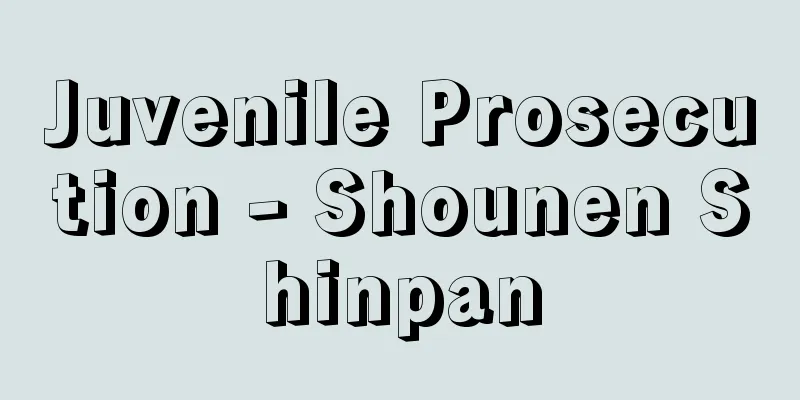Ruijufusensho - Ruijufusensho

|
A collection of laws compiled and classified in the late Heian period. Ten volumes. Also known as the "Sajosho." Contains over 730 documents, including dajokanpu (court documents), senji (imperial edicts), kansenji (official edicts), and gejo (letters of release) from the early Heian period to 1093 (Kanji 7). It also contains one kansen and one imperial edict from 737 (Tenpyo 9), but nearly two-thirds of the total are senji (imperial edicts). It also contains many documents not included in the "Ruijū Sandaikyaku" and mid-Heian period documents not found in other books, making it an important historical resource for research into the kuge system. The most widely accepted theory is that the editor was Minamoto no Tsuneyori, the Left Chief Historian, and it is believed that the Otsuki clan, who later succeeded him as the Left Chief Historian, transcribed it as a reference book for the Dajokan government affairs, and the oldest copy, from 1121-1122 (2nd-3rd year of Hoan), was kept secret for a long time by the Mibu Kanmuke family (currently in the possession of the Archives and Mausolea Department of the Imperial Household Agency). After Mibu Suetsura transcribed it around 1691 (4th year of Genroku), several other transcriptions were made, and published in 1820 (3rd year of Bunsei) by Hanawa Hokiichi. In addition to the edition compiled by the Imperial Household Ministry's Library Bureau, it is included in the Shintei Zoho Kokushi Taikei. [Yumino Masatake] "Research on Ruijufusensho by Kiyoshi Shimizu (1982, Toshokankokai)" Source: Shogakukan Encyclopedia Nipponica About Encyclopedia Nipponica Information | Legend |
|
平安時代後期に類別編纂(へんさん)された法令集。10巻。「左丞抄(さじょうしょう)」ともいう。平安初期より1093年(寛治7)までの太政官符(だいじょうかんぷ)、宣旨(せんじ)、官宣旨、解状(げじょう)など730通余を収載。737年(天平9)の官符、詔書各1通も含むが、全体の3分の2近くは宣旨で、『類聚三代格(さんだいきゃく)』未収文書や他書にみえない平安中期の文書を多数収めており、公家(くげ)制度研究の重要史料である。編者は左大弁(さだいべん)源経頼(つねより)とする説が有力であり、のち左大史(さだいし)を世襲した小槻(おつき)氏が太政官政務の参考書として転写したとみられ、1121~22年(保安2~3)の最古の写本が長く壬生官務家(みぶかんむけ)に秘蔵された(現、宮内庁書陵部蔵)。1691年(元禄4)ごろに壬生季連(すえつら)が書写してから数種の転写本が作成され、1820年(文政3)塙保己一(はなわほきいち)によって出版された。宮内省図書寮編本のほか、『新訂増補国史大系』に所収。 [弓野正武] 『清水潔著『類聚符宣抄の研究』(1982・図書刊行会)』 出典 小学館 日本大百科全書(ニッポニカ)日本大百科全書(ニッポニカ)について 情報 | 凡例 |
<<: Ruiju Myogisho - Ruiju Myogisho
>>: The origin of the Ruiju Shinto religion
Recommend
Oboso - Oboso
...A freshwater fish of the family Cyprinidae (il...
Capuchin monkey
...The Japanese name, Omakizaru, comes from the t...
Krupp Polysius AG
...The company is a holding company, with about 7...
Suruga Province
The old name of a province located in the eastern...
Ageo - Ageo
〘Noun〙 The name of the cord of the four-legged cro...
Amenity - amenity (English spelling)
Generally speaking, it means comfort, beauty, ele...
Shonai Domain
A domain that ruled over most of the Shonai regio...
Orvieto (English spelling)
A town in the province of Terni in Umbria, central...
Living material concept - Seigukannen
A translation of the Latin phrase idea innata. Ide...
Nakamura Jakuemon
A Kabuki actor. His stage name has been Kyoya for...
Acta Senatus - Acta Senatus
...Today, many newspaper companies apply this spe...
Abd al-Aziz
...The main content of the sense of crisis in mod...
Waka Yamada
1879-1957 A women's activist from the Taisho ...
Afferent nerve fibers
...For example, cats have 13 pairs of thoracic ne...
Internship - internship (English spelling)
A student undergoes work experience at a company ...









